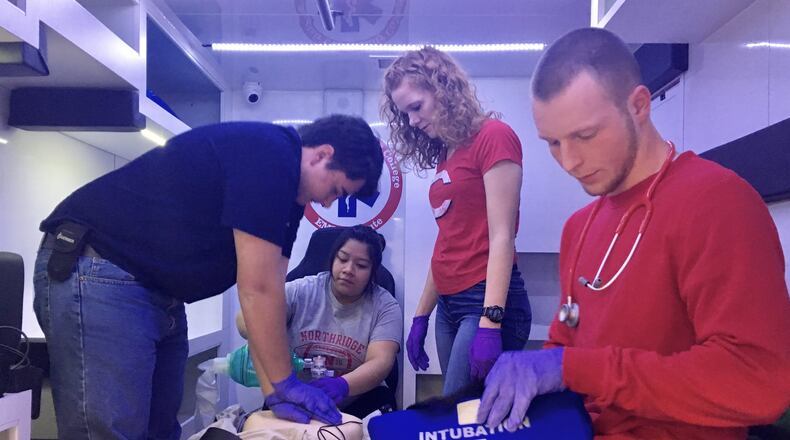In Ohio, new college degree programs must be approved by the state department of higher education and sometimes by a regional accrediting body. But, only one type of certificate faces an individual layer of oversight from an outside agency.
“That’s an enormous concern,” said Andrew Hanson, a research analyst at Georgetown University’s Center on Education and the Workforce. “There’s a strong bias in the community that some of these aren’t worth the paper that they’re printed on.”
Local community college administrators say their own internal processes are rigorous and aligned to meet workforce demands.
The programs also are reviewed frequently to gauge whether they are needed, Sinclair Provost David Collins said.
“We’re constantly looking to keep our curriculum fresh,” Collins said. “It’s really an ongoing effort to try to make sure that what we offer is relevant to the needs of the entire community.”
Varying degrees of oversight
The certificates that face the least outside oversight are created and approved in-house at colleges, often in collaboration with a local employer. Colleges have to notify the state that they plan to offer such certificates, but there is no mechanism by which the state can forbid schools from offering them.
A second type of certificate, such as one for an EMT, carries a technical designation and must be state-approved. A third type is carved out of a full degree and is typically used as a benchmark that serves as a more “achievable goal that people can see themselves accomplishing,” Sinclair’s Collins said.
The varying degrees of oversight have been a concern for the Ohio Department of Higher Education, said Brett Visger, associate vice chancellor for institutional collaboration and completion. For that reason, Ohio has tried to push schools toward offering certificates with technical designations and those embedded within already approved degrees, he said.
“That reduces the opportunity for malfeasance,” Visger said.
Sinclair offers around 168 certificates and 55 do not fall into the categories the state encourages colleges to seek. Clark State Community College offers 18 certificates and around a third don’t fall into the two encouraged categories, said Aimee Belanger-Haas, Clark State dean of business and applied technologies.
Although community colleges have historically been the schools that offer certificates, universities have recently gotten into the business. Wright State University, Miami University and the University of Dayton all offer certificate programs.
Absence of data
The extent to which certificates help people earn higher-paying jobs is hard to gauge.
Ohio tracks job placement for students with “less than associate degree awards,” but it does not specifically measure the placement rate of certificate holders from colleges and universities, ODHE spokesman Jeff Robinson said.
Hanson said colleges and government need to do a better job tracking performance.
“In a lot of cases we don’t know because we don’t have data,” Hanson said.
The statistics that are available show a mixed bag: The majority may pay off for workers, but some clearly don’t. Hanson estimates there isn’t a known job market for about 45 percent of the certificates awarded.
Pay for certificate holders also varies widely, with workers holding certificates in the fields of science, technology, math or engineering earning more. On average, workers with certificates earn around 20 percent more than people with just a high school diploma, according to Georgetown’s Center on Education and the Workforce.
Clark State’s Belanger-Haas said community colleges are responding to the desires of employers in the region.
“We don’t want to create a certificate that’s worthless,” she said. “Basically, it’s our employers that are standing behind them.”
Fast-growing sector
Certificates are the fastest growing sector of higher education.
The number of certificates colleges award has gown by 70 percent each year over the last two decades, according to Georgetown University. With a high demand, few hoops to jump through and low overhead costs, it’s easy for colleges to create certificate programs and turn a profit.
“It is a big business,” Hanson said. “This is the way that they make money.”
Sinclair awarded a record number of academic credentials last year, driven largely by the number of certificates it handed out. Of the 5,047 academic credentials during the 2016-2017 school year, 3,148 were certificates, according to the college.
Sinclair spokesman Adam Murka said it’s difficult to measure the direct financial impact certificate offerings have on the school’s budget, in part because students frequently earn a certificate while completing a larger degree.
At the University of Dayton, which has 30 certificate offerings — including three new ones being offered this year — the programs are seen as a response to the training requirements needed by employers, said Amy Anderson, UD associate provost for global and intercultural affairs.
RELATED: UD renames former NCR world headquarters for former school president
“Employer surveys tell us that intercultural competencies are among the top three things employers are looking for in the graduates today,” she said of UD’s international and intercultural leadership certificate. “The certificate gives students the experience and background to be able to demonstrate to future employers their global competencies and the things they have learned.”
By the numbers
70 percent: Growth in college certificates awarded over the last 20 years.
20 percent: Average pay increase for a certificate versus high school diploma.
168: Number of certificate programs offered at Sinclair Community College.
3,148: Number of certificates Sinclair awarded during 2016-2017 school year.
About the Author
